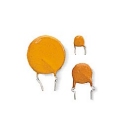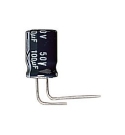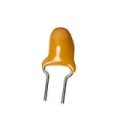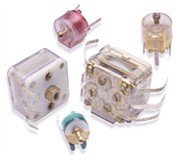Capacitors are used to store electricity and also to block direct while passing alternating current. They come
in many different sizes and capacitance is measured in farads. A one farad capacitor would be HUGE so they are
actually measured in small fractions of farads. The two most commonly used are the microfarad and the
picofarad. A microfard (uF) is .000001 of a farad while a picofarad (pF) is .000000000001 of a farad.
Personaly, I find trying to figure out capacitor ratings that are printed on the ceramic type of capacitors
confusing. What I do when I purchase them is just to make sure that I keep them in the package that they come in, instead of trying
to figure them out. The electrolytic type of capacitors are much easier to read and figure out.
Capacitors also have a votage rating, and it is very important that you do not exceed the voltage ratings of
the capacitors (trust me, they will explode!). In other words if a project calls for a capacitor with a voltage
rating of 12 volt, you can use one rated at 20 volt, just DO NOT use one rated at 6 volts.
One last percaution working with capacitors is their ability to store a charge even after they are switched off.
This is the main reason for the "TWO MINUTE" wait after turning off power to the PEB before removing or
inserting any card. This allows time for the capacitors to dis-charge. Keep in mind though that some
high voltage capacitors can hold enough charge to be letal. I hate to admit it but I have melted the tips off
of screwdrivers when I shorted one of these, I wouldn't have wanted that charge to go through me!
Figure 1 shows the 4 most common type of capacitors, though their are others, these will be the ones that we
would be working with. On the left is shown 3 different sizes of ceramic or disc type capacitors. These type
can be put in any direction on a circuit board as they have no polarity. The next type is an electrolytic
capacitor. These are generally quite larger and do have a polarity, and must be soldered on correctly. They
usally have a white stripe pointing at one of the leads, and these are usually the negative lead. The next
type shown is a special electrolytic type of capacitor called a tantalum. The most important thing here is that
if a circuit calls for tantalum capacitor be sure to use one. They must be inserted correctly as they also
have a polarity. Usally they have a small + on near the positive lead.
The last type in figure 1 is the variable capacitor. We won't run into many of these, but they are used on some
of the TI cards. One is used on the P-Gram + card to allow one to adjust the clock if it is running fast or slow.

Schematic Symbol for Electrolytic Capacitor

Schematic Symbol for Ceramic or Disc Capacitor

Schematic Symbol for Variable Capacitor
|








